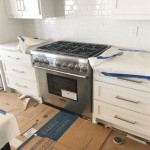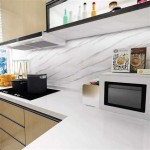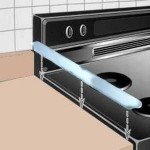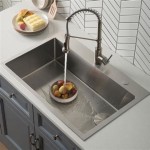Understanding Spacers Between Stoves and Countertops
The installation of a stove within a kitchen countertop setup often necessitates the consideration of gaps or spaces that may exist between the appliance and the surrounding surfaces. These spaces, while seemingly minor, can significantly impact the aesthetic appeal, functionality, and safety of the kitchen environment. Addressing these gaps effectively requires a thorough understanding of their causes, consequences, and potential solutions, including the use of appropriate spacers. This article elucidates the complexities surrounding spacers between stoves and countertops, providing a comprehensive overview of this often-overlooked aspect of kitchen design and appliance installation.
The presence of gaps between a stove and the countertop is a common occurrence, arising from a multitude of factors. Manufacturing tolerances, variations in countertop material thickness, and imperfections in the leveling of the stove itself can all contribute to these discrepancies. Furthermore, the natural settling of a home's foundation over time can subtly alter the alignment of kitchen cabinetry, potentially exacerbating existing gaps. The type of stove, whether it's a freestanding range, slide-in range, or cooktop with a separate oven, also influences the likelihood and nature of these spaces. A freestanding range, for instance, may have more pronounced gaps on its sides compared to a slide-in range designed to fit flush with the countertop.
The material composition of both the countertop and the stove also plays a role. Countertops made of natural stone, such as granite or marble, may exhibit slight variations in thickness due to the inherent characteristics of the material. Similarly, the enamel or stainless-steel finish of the stove's exterior can have minor irregularities that create uneven contact points with the countertop surface. Understanding these contributing factors is crucial for accurately assessing the extent of the gap and determining the most suitable corrective measures.
The Potential Problems Associated with Stove-Countertop Gaps
The existence of spaces between a stove and the countertop is not merely an aesthetic concern; it presents several practical problems that can negatively impact the kitchen environment. One of the primary issues is the accumulation of food debris, liquids, and grease within these gaps. This debris can be difficult to clean and, over time, can become a breeding ground for bacteria and mold, posing a health hazard. The resulting odors can also compromise the overall cleanliness and freshness of the kitchen.
Beyond hygiene concerns, these gaps can also attract pests, such as insects and rodents, which can find refuge and sustenance within the concealed spaces. These pests can contaminate food preparation areas and potentially spread diseases. The accumulation of grease and flammable materials within the gaps also increases the risk of fire hazards, particularly if the stove is a gas-powered model. Sparks from faulty igniters or open flames can easily ignite the accumulated debris, leading to a potentially dangerous situation.
Moreover, gaps can negatively impact the structural integrity of the countertop, particularly if it's made of a fragile material like laminate or engineered stone. The constant vibration and movement of the stove during use can exert pressure on the edges of the countertop, potentially causing chipping, cracking, or even complete failure over time. Finally, the presence of gaps can simply be unsightly and detract from the overall aesthetic appeal of the kitchen, diminishing the perceived value and quality of the space.
Types of Spacers Used Between Stoves and Countertops
To mitigate the problems associated with stove-countertop gaps, various types of spacers are available. The selection of the appropriate spacer depends on the size of the gap, the materials of both the stove and countertop, and the desired aesthetic outcome. One common type of spacer is a simple silicone or rubber strip, designed to fill the gap and create a seal that prevents debris from entering. These strips are typically flexible and easy to install, often adhering to the countertop with an adhesive backing. They are available in various colors to match the countertop or stove finish.
Another option is a custom-made spacer crafted from materials such as wood, metal, or acrylic. These spacers are often fabricated to precisely fit the specific dimensions of the gap and can be designed to seamlessly blend with the surrounding kitchen cabinetry. Custom spacers offer a more professional and aesthetically pleasing solution, but they typically require more time and expense to design and install.
For larger gaps, a more substantial spacer may be necessary, such as a trim piece or a filler strip. These components are typically made of wood or metal and are designed to cover a larger area, providing a more robust and visually appealing solution. Trim pieces can be installed along the sides or back of the stove, effectively bridging the gap and creating a finished look. In some cases, a small amount of shimming may be required to ensure that the stove is level before installing the spacer.
Furthermore, specialized gap fillers designed specifically for kitchen appliances are also available. These products often feature a unique design that allows them to flex and conform to the contours of the stove and countertop, creating a tight seal and preventing debris from entering. They are typically made of durable, heat-resistant materials that can withstand the rigors of daily kitchen use. The selection of the appropriate spacer should carefully consider the specific requirements of the kitchen and the desired aesthetic outcome.
Installation Techniques and Considerations for Spacers
Proper installation of spacers is crucial to ensure their effectiveness and longevity. Before installing any spacer, it's essential to thoroughly clean the surfaces of both the stove and countertop to remove any dirt, grease, or debris. This will ensure that the spacer adheres properly and creates a tight seal. The use of rubbing alcohol or a degreasing cleaner is recommended to prepare the surfaces for installation.
When installing a silicone or rubber strip, it's important to measure the length of the gap accurately and cut the strip to the appropriate size. The strip should be carefully positioned along the edge of the countertop, ensuring that it is aligned properly and that there are no gaps or overlaps. The adhesive backing should be firmly pressed against the countertop to create a secure bond. Any excess material can be trimmed away with a sharp knife or utility blade.
For custom-made spacers, professional installation is often recommended to ensure a precise fit and a seamless finish. A skilled carpenter or contractor can accurately measure the gap, fabricate the spacer to the exact dimensions, and install it securely using appropriate fasteners and adhesives. The spacer should be carefully sanded and finished to match the surrounding cabinetry or countertop material.
When installing trim pieces or filler strips, it's important to ensure that the stove is level before installing the spacer. This can be achieved by using shims to adjust the height of the stove until it is perfectly aligned with the countertop. The trim piece should be securely fastened to the cabinetry or countertop using screws or nails, ensuring that it is flush with the surrounding surfaces. Any gaps or imperfections can be filled with caulk or wood putty and then painted or stained to match the surrounding finish.
Regardless of the type of spacer used, it's important to regularly inspect it for any signs of wear or damage. If the spacer becomes cracked, loose, or discolored, it should be replaced promptly to maintain its effectiveness and prevent the accumulation of debris. Periodic cleaning with a mild detergent and water will also help to keep the spacer clean and prevent the growth of mold or mildew.
Considering the heat generated by the stove, selecting a spacer material that can withstand high temperatures is paramount. Silicone-based spacers are often preferred because of their heat resistance, flexibility, and durability. Spacers made from wood or certain plastics may warp or melt if exposed to prolonged heat, potentially creating a fire hazard. Always consult the stove manufacturer's recommendations and local building codes to ensure that the selected spacer material is safe and compliant.
Furthermore, the color and texture of the spacer should be carefully considered to ensure that it complements the overall aesthetic of the kitchen. Choosing a spacer that closely matches the countertop or stove finish will help to create a seamless and integrated look. Alternatively, a contrasting color can be used to create a visual accent and add interest to the kitchen design.
Finally, when selecting a spacer, consider the ease of cleaning and maintenance. Spacers with smooth, non-porous surfaces are generally easier to clean and less likely to harbor bacteria or mold. Avoid spacers with intricate designs or textures that can trap dirt and grease. Regular cleaning with a mild detergent and water will help to keep the spacer clean and hygienic.

Filling Cabinet Gaps Around Our Stove Young House Love

These 10 Gap Covers Solve The Most Annoying Problem With Your Stove

1 3 8 Wide Brushed Stainless Steel Kitchen Stove Counter Top Gap Filler Trim Cap 2 Pack

Filling Cabinet Gaps Around Our Stove Young House Love

Kozyland Stove Gap Covers Stainless Steel Oven Filler Heat Resistant Easy To Clean Between And Counter Guard Black 23 5 L 0 9 W

Filling Cabinet Gaps Around Our Stove Young House Love

What To Do With Empty Space Between Counter And Stove

Magic 1 4 In X 20 Counter And Appliance Gap Eraser Aluminum 3021

How To Fill The Gap Between Stove And Counter

10 Projects S To Fill Awkward Appliance Gaps








